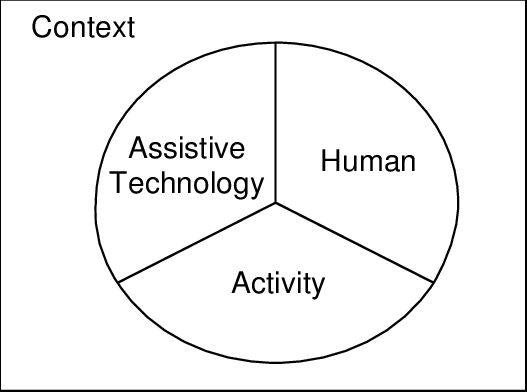
Overview
The Human Activity Assistive Technology model describes a process of technology development and service that is structured to focus on the persons who will use it. Its four primary components include Activity, Human, Context, and Assistive Technology. Within this approach, the activity and context of the human to use the equipment, takes precedence over the equipment itself. In other words, the design of the technology is driven by the characteristics of the human users, the activities they will perform, and the context in which they will do so. The context component means that social factors are considered along with the activity, not solely the functionality of the device (Cook et al., 2020).
All the other components are considered under or within the given context. This context includes physical, social, cultural, and institutional elements. Physical refers to the environment, such as the terrain, amount of light, noise, or heat present. Resource availability, etc. Social refers to the people present within the environment where the technology will be used and the attitudes these individuals may have that could influence the technology user. Cultural is larger than social and refers to the wider values or common practices of a group to which the user considers him or herself to be a member of. Institution refers to the rules or policies regulating or limiting acquisition of technology.
Assistive technology component is the tool by which the human performs the activity within the context. The Assistive Technology is also comprised of four factors: the Human Technology Interface, the processor, the environmental sensor, and the activity output. Basically, this means that the human and the technology interact with one another, and this enables the person to perform the intended activity in the given context.
Example
Suppose a TVI used the HAAT model to help her decide which screen reader would be most appropriate for her 5th grade student attending a public school. First she considers the human. taking into account the needs and preferences of the student based on his vision, input, skill level, and experience with technology so she can ensure the equipment chosen has all of the necessary features. Second, she considers the activities he will be required to perform with the screen reader. His teacher uses Google Classroom for delivering content and assigns students work requiring the use of Google Workspace. The class uses these tools on a regular basis and the teacher provides directions specific to these platforms. It is a 1:1 school and each student is provided with a Chromebook to use during the year for schoolwork. She must choose a screen reader that can navigate and perform these tasks. Then, she considers the context in which the device will be used. Socially, her student will use it in a classroom with many other students and he prefers not to stand out too much. From this, she knows he will want a set up that is as similar as possible to what his classmates are using to support positive social interaction as part of the group. Physically, will the noise level in the classroom require the student to use a braille display for reading or would speech output with headphones suffice? From an institutional standpoint, it would be much harder to convince administration to sanction the cost of purchasing an alternative system for this student when the Chrome system is already provided and no additional cost is required to put a screen reader onto it.
All these factors lead to the conclude that she should allow him to use his Chromebook just like the other students so he will feel comfortable and included, while also providing him instruction on effectively using the built-in accessibility features such as the ChromVox screen reader and/or braille support to access Google Classroom content and work with Google Workspace to complete assigned tasks.
Reference
Assistive Technology: Principles and Practice by Albert Cook PhD
Cook, A. M., Polgar, J. M., & Encarnação, P. (2020). Assistive technologies: Principles & practice. St. Louis, MO: Elsevier.
